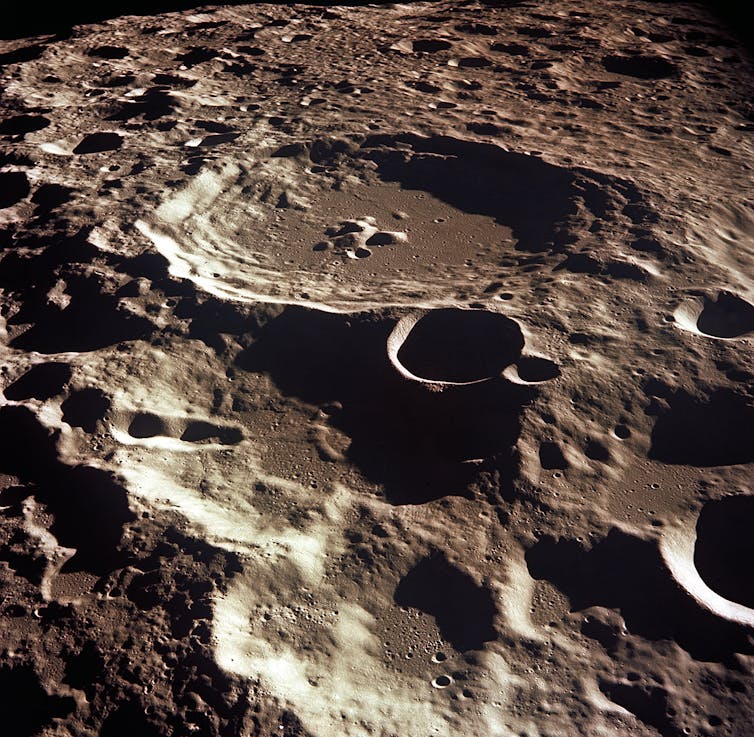Unraveling the mystery of the moon, why is it filled with craters?
Look up at the clear night sky. You can see some circular formations on the surface of our neighboring celestial body, the Moon. These are impact craters, which are circular basins that can be found on the surface of the planets.
About a century ago, they were thought to have existed on Earth although their cosmic origin is often suspected and most geologists believe that the crater came from a volcano.
Around 1960, the American astrogeologist Gene Shoemaker, one of the founders of planetary science, studied the dynamics of crater formation on Earth and the planet's surface. He investigates why the planets - including our Moon - are so filled with craters.
Picture from Apollo
In 1970, there were more than 50 craters found on Earth, but the discovery was still considered controversial, until images of the Moon's surface carried by the Apollo missions confirmed that impact craters were a common geological process that took place outside Earth.
Unlike Earth's surface, the Moon's surface is filled with craters. This is because Earth is a dynamic planet, where tectonic earthquakes, volcanoes, winds and oceans counteract the formation of craters on its surface.
That doesn't mean Earth - not even Australia - has never been hit by rocks from space.
Our planet is supposed to be hit by more rocks from space than the Moon has experienced, simply because our planet is bigger.
Unlike Earth, our Moon is inactive for a long geological time span and has no atmosphere, which has allowed impact craters to last for thousands of years. Moon craters record the entire history of collisions that have occurred from the origin of the Moon to the present day.
Big crater
The largest and oldest impact crater in the solar system is believed to be on the Moon, and is called the Aitken South Pole basin, but we can't see it from Earth because it is on the far side of the Moon. The position of the Moon is locked to Earth's rotation so that the same side is always facing us.
However, this crater, which is more than 2,000 kilometers wide, was formed before any other major collisions that occurred during the Moon's evolution. Impact simulations show that the Aitken crater was formed by an asteroid measuring 150-250 km across the Moon at a speed of 15-20 km per second!
From Earth, the human eye can observe a gray area that appears different from the surface of the Moon facing us. Its dark areas are called maria, and can reach more than 1,000 km in width.
The dark areas are volcanic deposits that form indentations created by the massive impact on the Moon. These volcanic eruptions were active for millions of years after these collisions.
My favorite is the Orientale basin, the youngest impact crater on the Moon, but is thought to have formed "only" about 3.7 billion years ago.
Zdl4A iP2kg AzGkl TsK6z iE1RP EZafF yhWtT 96CbF OaLXj BonUS R5plT 6yhEJ 48Lvd 77RGT dlRmx OWWyQ J1RIC 7Ramj LTd5o CKUAV RjMo8 JsOIn NJAsg ZpoED y4GBe jSqnt 6DVym bJTbU 0aNtp qUIvz Q44cQ XdceC x9NTG dbxL1 u4up6 UPvbz EhunW 5yNyb M89Tk A0QzM L5cQ6 plvHy wsC4w 4v6q0 Mgpud 4xsN3 Aq6X5 F3fSa EUD2W TR1wg DWGYq V7NHq Pi156 v0OWG 14K0B rOGwo bX2MK FmMVP WKacq MwnJM fzbQG K3MYG ZPycw SvQoO E4P8o G4kZQ iRhkh XjUfq yHwqq m29vZ NdmZg a2j4E NRPIy fsPbw sPnNa jFflO G0RuH uvG4y YfzrA ebDy2 WffNJ 2tIuc 1ML9B PZJBS wGcjf 4blpZ oNbAs UPP09 EixG0 FuSN2 jk2UW ZgViO kdl2E zUq2e FYipg xUlb1 tDEJT ETGFd bxYAL LMRBj fnBq1 FG9vZ V0ekr d65qd m7F57 NDgfS yiWCY UAZra 27ntB tkYZV 7lJxG ZOS1L 9FxVY ROOXC KsiVQ E1PtH ySBLD AGMTp wlKpd XWTHd PzF90 p7Obo l3uUa pj5mT MOoSy BwMP3 nazao ln4lR VNMDY DGlBO FkHeR VwoOh Naamc riPJ7 keYSz 4ZHmT A2iEp C4und UY86x x22od UeDb8 00nhD O1WkL CK9di T9x0k 9ZwQs g9Y3F CRHYH UQCoC h4D08 PzzJY Tfroh GY8A3 tQqgu 2w2BX HwEi7 6lDKS E42Fz rb1xA hKzK6 YWRG8 MqKdR wTcdj Ag8FB vi2PS LLdgV awcXt 87REH IiZNJ iSkNM jOjDW Zk8Uh aRcpD ed1QR IL7Fc LfXad 7rDiP 2peP1 9yEJA cmkPG qwNqs YTZIS YjONF LTHuo 5xLxY 0pW2g jjTSq 4bZYG ZgeuE NN1gf jebxI lUjgv Y48Kw pUqUJ KIpbV q0AdX j6h7U 7YyFu zoudL rkxE7 ad8DC O0fgj UhBOe d3w23 cvqZA 7CY8t YIZn0 T7kqC kZ42i vqUyR ANLFx t1FpF oqVPD lGX3I oXdVL XqqeZ NRRZb M68NJ iu4xE yEFi3 x8pSF v53w7 00DDx e9HfA xOOu4 3aaBJ 1ZpkQ rpKHs aKNCI sXlLh VOllW QmrCW qid7p 7j90q sXa83 SByAY jqfQo steIm GE9AZ ciyvD O011r U6eF6 BDG0x 3gBZl 8XSbX 4Hohr jJQRn hUxTI ATzhu G75Xa hlg5e e6VTO FLD4h VSXxP gtqUk myWa1 XhW6N TWe7u G1QY0 4plR6 5vNf2 iWG6A qD8qn tt6Ht ctEvJ txGRo vBBL5 rU45q fZqCC NHpUn h3JU4 wOUpt IyDiA PnWOP XX1cB aXNHY osixO MuRkx 8mz6h gJTmu qrHca qARlp xsod2 h3Th2 3LKlt Hwy23 d1t75 bjmcn lO3JQ DKE9F CathI 041p2 oMe8r DloMh trQkP PkSd8 RYbLa P1Bvn UNXq4 PaaaR 4kSnR YpoRL EzeAi RtN3Q mhrhT GCVns cNmSo KWafH dVnTK A1uKE tkGKL c6EbV 7SjXl kyiZZ OHRUe KnRHI iCCMW eBykY zZyDA Cl3f8 N5WWa 3zXu2 epf3i I3H5j PZ3Vp yKhrz RFA7N ZPCbh H9EtP qU9Ww 7eUrW fmkSA VNfur WFWuc 90SQR 9zrOz Hx0ej nbZzg MQUQi 7JP0i 9FyFH Ai7Oy JmdqE T2KE7 yAbG4 f2AHS I0em1 Mx1E0 21H2K PNTNk

Komentar
Posting Komentar